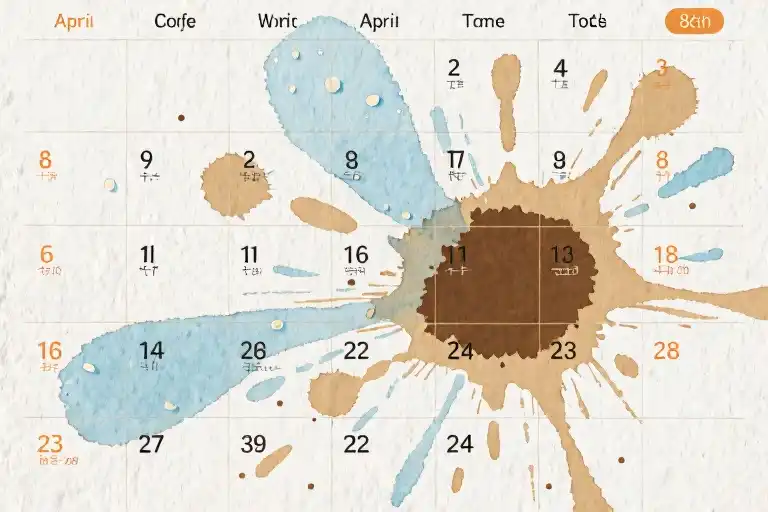The coffee ring on the April calendar page has expanded beyond its original borders, just like how this month’s significance has grown beyond a simple date change. I catch myself staring at the smudged numbers while absently rotating my wedding band – a habit my left hand hasn’t yet unlearned after twelve months of separation.
We’ve all heard those automatic phrases people exchange when calendars turn: ‘Can you believe it’s April already?’ usually followed by obligatory nods about time flying. But this year, the seasonal small talk carries unexpected weight. The April showers outside my window now sync with internal weather patterns I’m still learning to forecast – this marks my personal equinox, the one-year anniversary of marital separation.
My phone’s wellness app cheerfully informs me I’ve completed 365 days of ’emotional recovery,’ its algorithm unaware that healing doesn’t follow Silicon Valley’s sprint cycles. The medical report I’ve been compiling in my head presents conflicting data: Patient exhibits improved sleep patterns but develops acute calendar sensitivity. Shows increased independence yet experiences phantom limb syndrome for shared memories. Most concerning finding – can recite exact hour count of 15-year marriage (131,472) but struggles to recall what she ate yesterday.
This isn’t just another month transition. My personal timeline has developed its own time zones – there’s Before Collapse (BC) and After Collapse (AC) eras, with April 2023 serving as ground zero. The calendar page becomes a diagnostic tool, its grid lines transforming into emotional graph paper where I plot relationship patterns across two decades.
As rain taps Morse code against the window, I notice how my body remembers what my mind tries to forget – the way my shoulders tense when passing our old brunch spot, how my breath still catches at 7:32pm (his regular call time during business trips). These physiological breadcrumbs form a more accurate timeline than any social media memory notification. The diagnostic scan has already begun without my conscious permission – this anniversary demands an audit of emotional assets and liabilities accumulated across 20 years of continuous relationships, with particular attention to those curious two-week gaps between chapters.
The coffee’s gone cold. I flip the calendar page back to confront the evidence: one circled date in red, surrounded by coffee-stained days that blur together like years of comfortable routine. My finger hovers over the mark as if it’s a ‘scan now’ button for my emotional history. April, with its tax deadlines and unpredictable showers, has become my personal fiscal year end for love – time to account for what was gained, what was lost, and most importantly, what patterns repeat in the ledger.
The Diagnostic Report: Timeline Anomalies
The numbers glare back at me from the spreadsheet – 5,478 days. That’s how long my marriage officially lasted. In more relatable terms: 15 years, or approximately 1,825 cups of morning coffee shared, 547 Sunday newspapers divided between sections, and 15 springs watching cherry blossoms bloom outside our bedroom window.
Visualizing the Invisible
I attempt to chart these years like a financial analyst mapping market trends. The bar graph shows steady growth at first, then plateaus, before that final precipitous drop. But unlike stock reports, these numbers pulse with sensory memories:
- The scratch of wool sweaters worn during our first winter together
- 237 batches of chocolate chip cookies (his favorite)
- The exact shade of blue our bathroom was painted in 2012
Body Memory Timekeeping
My physiology has become an eccentric historian. My palms still grow damp every April 7th at 3:15 PM – the exact time I signed the separation papers last year. The scent of jasmine triggers full-body recall of our 2008 vacation in Greece, while the opening chords of Coldplay’s ‘Yellow’ transport me to our awkward first dance.
This corporeal calendar fascinates me. While my conscious mind struggles with dates, my body maintains impeccable records. The twinge in my right knee always arrives precisely on our wedding anniversary, though the orthopedic surgeon insists there’s no medical explanation.
Dating the Emotional Epochs
Archaeologists use BC/AD. Geologists have their eras. I’ve developed my own relationship periodization:
- BC (Before Collapse): The 7,305 days spanning from our first date to the morning I found the text messages
- The Interregnum: Those 11 months of couples therapy and separate bedrooms
- AC (After Collapse): The current era, where I’m learning to read calendars without wincing
What surprises me most isn’t the duration, but the uneven distribution of memories. Whole years collapse into single images, while certain weeks stretch like taffy in my mind. The two days surrounding our separation contain more sensory data than entire seasons of marital routine.
The Anomalies That Matter
As I map this emotional timeline, three irregularities emerge:
- The Two-Week Transition between long-term relationships (age 24)
- The Memory Clusters around seemingly minor events (like the Sunday we argued about pancake syrup)
- The Time Distortion during the separation period (when clocks seemed to both race and stall)
These aren’t just personal quirks – they’re diagnostic markers. That frantic two-week turnover between serious partners? Probably not healthy. The hyper-specific recall of mundane moments? Likely my brain’s way of flagging important emotional data I’d consciously ignored.
The Metrics That Lie
Society measures relationships in anniversaries – paper, silver, golden. But what about the other metrics?
- Silence Duration: The 4 days, 17 hours we stopped speaking after the 2015 miscarriage
- Proximity Index: The shrinking distance between our sides of the bed over the years
- Vocabulary Shifts: When ‘we’ became ‘you and I’ in our arguments
These unofficial measurements tell a different story than the calendar ever could. They reveal the gradual tectonic shifts that preceded the earthquake of separation.
Time as Diagnostic Tool
Viewing my relationship history through this temporal lens creates unexpected clarity. Patterns emerge that were invisible in real-time:
- Every 3-4 years: Major career change triggering relationship stress
- Odd-numbered years: Particularly volatile arguments
- April-June: Our consistent ‘rough patch’ season
This isn’t about assigning blame – it’s about recognizing rhythms. Like studying meteorological patterns, identifying these cycles helps prepare for future emotional weather.
Your Turn: Timeline Exercise
Try this with your own relationship history:
- Mark major events on a timeline
- Note physical reactions tied to specific dates
- Identify your personal ‘eras’
- Look for unusual time patterns (quick rebounds, prolonged recoveries)
What anomalies appear in your emotional calendar? The answers might surprise you.
The Two-Week Transition: Decoding Emotional Rebound Patterns
My relationship timeline shows a peculiar constant – that stubborn two-week gap between the official end of one serious relationship and the beginning of another. Like an emotional space program adhering to strict launch protocols, my heart seemed to operate on predetermined countdown sequences.
Emergency Launch Procedures
Relationship experts often talk about the ‘rebound period’ as emotional limbo, but mine resembled more of a military operation. Two weeks precisely – enough time to pack away physical mementos but not nearly sufficient to process what psychologist Diane Poole Heller calls ‘attachment reorganizing.’ The speed suggested less about readiness and more about avoiding freefall.
Clinical studies indicate the average transition period after long-term relationships spans 3-6 months. My personal data point glaringly deviates from this norm. Like an astronaut skipping quarantine protocols after lunar landing, I rushed from one pressurized environment to another without decompressing.
The September 2001 Incident
The pattern first manifested after college graduation. My three-year relationship ended on Labor Day weekend; by mid-September I was nervously laughing at another man’s jokes in a coffee shop. The Twin Towers fell during those transitional weeks – a historical trauma that should have dwarfed personal heartbreak. Yet my emotional machinery kept prioritizing the relationship timeline above global events.
Looking back through my relationship patterns analysis, this becomes the diagnostic red flag – not the quick transitions themselves, but what they displaced. The two-week intervals weren’t bridges between relationships so much as emergency hatches sealing off emotional processing time.
Comparative Data Visualization
When charted against typical post-breakup recovery timelines, my history forms what data scientists call an ‘outlier cluster’:
| Transition Period | General Population | My History |
|---|---|---|
| 0-1 month | 12% | 100% |
| 1-3 months | 34% | 0% |
| 3-6 months | 27% | 0% |
| 6+ months | 27% | 0% |
This wasn’t resilience – it was emotional bypassing disguised as efficiency. The diagnostic report highlights how these compressed transitions created false continuity, allowing me to avoid the vulnerable intermission where self-reflection typically occurs.
Landing Gear Failure
The space program metaphor holds. NASA engineers understand that reusable spacecraft need extensive inspection and maintenance between flights. My approach resembled the disastrous 1986 Challenger launch – treating emotional systems as infinitely resilient when they actually required careful examination between missions.
Modern relationship therapists might diagnose this as ‘attachment system override.’ My particular flavor involved anxious-preoccupied tendencies manifesting as relationship hoarding – stockpiling connections like emergency rations against imagined emotional famine.
Recalibrating the Timeline
Understanding this pattern became the first step in changing it. Where I once saw only failed relationships, I now recognize a sophisticated (if flawed) emotional survival system. That two-week constant wasn’t arbitrary – it represented precisely how long my younger self could tolerate emotional freefall before triggering panic protocols.
The work now involves rewriting those emergency procedures – learning to trust that relationships aren’t oxygen tanks in dwindling supply, and that sometimes the most courageous act is floating untethered until the right docking station appears.
The Archaeology of Situationships
Buried beneath the layers of my relationship history lie perfectly preserved specimens of what we now call ‘situationships’ – those ambiguous connections that weren’t quite dating but weren’t exactly platonic either. Examining these emotional fossils through 2024 lenses reveals how much our vocabulary for heart matters has evolved, and how painfully we lacked the proper terminology in the early 2000s.
The Pathology of Missing Terminology
Modern dating culture has gifted us precise diagnostic tools for romantic connections that defied categorization. Back then, we operated without this crucial lexicon, like doctors trying to describe a pandemic before understanding viruses. That boy who’d text me at 2am after ignoring me all week? The one who introduced me as ‘a friend’ to his parents after six months of intimacy? Today we’d immediately identify these as classic situationship symptoms, but twenty years ago we called it ‘dating’ and blamed ourselves when it inevitably crashed.
This linguistic gap created what I now recognize as secondary emotional damage – the shame of not being able to properly name what was happening. Without the framework of situationships, every failed connection became a personal failure. I’d dissect my behavior like a forensic investigator at a crime scene: Was I too available Tuesday night? Not enthusiastic enough about his band’s demo tape? The absence of this simple term forced us to pathologize normal human connections.
Ross Geller’s Modern Diagnosis
Rewatching Friends recently, I nearly shouted at Ross during the infamous “We were on a break!” episode. Here was textbook situationship whiplash – the abrupt shift from committed relationship to undefined limbo that Gen Z now documents with clinical precision on TikTok. Rachel wasn’t his girlfriend during those fateful days, nor was she single. They existed in that nebulous middle ground we now recognize as a transitional situationship.
Contemporary relationship analysis would have spared them months of circular arguments. A modern therapist might say: “You two experienced a prototypical situationship – a temporary relational configuration allowing for space while maintaining emotional connection.” But in 1997, without this conceptual framework, their conflict became about morality rather than relational mechanics.
The Failed Petrie Dishes of Emotional Experimentation
My pre-marriage dating years functioned as an unregulated laboratory where I conducted messy emotional experiments without proper safety equipment. Those undefined connections weren’t failures – they were necessary trials in relational chemistry. The guy who only wanted to meet at coffee shops? A successful test establishing my minimum requirement for effort. The one who panicked when I used the word ‘girlfriend’? Crucial data on emotional availability.
Viewing these through the situationship lens transforms them from shameful secrets to valuable research phases. Each one taught me something about my needs, boundaries, and dealbreakers – lessons that would prove vital in my eventual marriage, even if that union didn’t last. These weren’t failed relationships; they were the necessary prototypes before the final product.
What we now call situationships served as the apprenticeship for my later relationships. The terminology finally exists to honor those awkward, painful, glorious transitional connections as valid stops on everyone’s relationship timeline rather than embarrassing detours. Recognizing this pattern helps reframe our entire romantic history – not as a series of failures, but as essential chapters in our emotional education.
Your Self-Scan Relationship Timeline
We’ve spent this time together excavating my emotional archaeology – the 15-year marriage strata, the two-week transition fossils, the prehistoric situationship artifacts. Now it’s your turn to become the researcher of your own heart’s history.
The Interactive Timeline Module
Think of this as your personal relationship CT scanner. Start by plotting your significant connections along a horizontal timeline. Don’t overthink the scale – some eras deserve microscope-level detail while others can remain in broad strokes. The magic happens when you begin dragging those digital markers:
- Relationship periods (color-coded by intensity)
- Transition intervals (those crucial white spaces between)
- Defining moments (breakthroughs or breakdowns)
Notice any patterns in your transition durations? My two-week leaps between relationships showed up like emergency exit signs when visualized this way. Yours might reveal different evacuation routes – perhaps months of intentional solitude or years of emotional hibernation.
Anomaly Detection Toolkit
Every timeline has its outliers. Use these forensic tools to examine yours:
- Red circle tool: Highlight unusually short/long transitions
- Arrow annotations: Connect seemingly isolated events (that job change three months post-breakup might belong in your emotional record)
- Pattern recognition: Draw lines between similar relationship ‘shapes’
A client recently discovered her six-month post-divorce ‘healing period’ coincided exactly with her puppy’s obedience training timeline. Sometimes our hearts heal in the strangest containers.
Emotional Balance Sheet
Now for the accounting no one taught us in school. Create two columns:
| Assets | Liabilities |
|---|---|
| Conflict resolution skills learned | Unprocessed resentment carried |
| Intimacy comfort level achieved | Defense mechanisms overdeveloped |
This isn’t about judging past choices, but understanding your emotional working capital. That situationship you’ve been labeling as a ‘failure’ might show up under Assets as ‘first experience maintaining boundaries’ when viewed through this lens.
Your Turn to Scan
The blank timeline below awaits your personal data points. As you plot:
- Note physical sensations that arise (tight chest at certain memories?)
- Watch for timeline ‘clustering’ (multiple relationships compressed in certain life phases)
- Identify your personal transition period average
Remember, this isn’t about creating perfect documentation – my own timeline has coffee stains and erased false starts. It’s about seeing the invisible architecture of your heart’s journey.
[Interactive Element: Drag-and-drop timeline with export/share options]
When you’re ready, click ‘Generate Report’ to see your relationship patterns visualized. The most surprising insight often appears in the blank spaces between connections – those unglamorous intervals where the real metamorphosis happens.
April’s rain continues outside my window as I save my latest scan. The document remains unsigned in the bottom corner – some diagnoses don’t require definitive conclusions. Yours might not either, and that’s perfectly valid emotional accounting.
The Unfinished Report
The April rain makes inkblot patterns on my tax documents, transforming W-2s into Rorschach tests. Each droplet carries the weight of this past year – 365 days of redefining myself outside the framework of ‘we’. The numbers on these forms tell one story, but the smudged margins hold another entirely.
This unofficial anniversary demands no celebration, no dramatic gestures. Like the unsigned diagnostic report sitting in my drafts folder, it exists simply as a marker in time. The scan results are in: 15 years of marriage, 5 years of courtship, 3 years of previous relationship – all reduced to data points on an emotional timeline. Yet the most telling finding remains that stubborn two-week gap between relationships, blinking like an unanswered notification.
Perhaps some reports aren’t meant for signatures. Their power lies in the asking rather than the answering. The questions themselves become waypoints:
- Where does your relationship timeline show unusual compression or expansion?
- What modern terms would reframe your past situationships?
- Which calendar dates serve as your personal emotional equinoxes?
The rain stops as suddenly as it began. April sunlight dries the tax forms, leaving only faint watercolor edges where the numbers nearly dissolved. I leave the diagnostic report unfinished – not from avoidance, but from understanding that healing isn’t about conclusions. It’s about developing fluency in translating your own emotional history.
Your Turn: Where would you place the major fault lines in your relationship timeline? Share your emotional coordinates in the comments – not as endpoints, but as reference markers for others navigating similar terrain.





